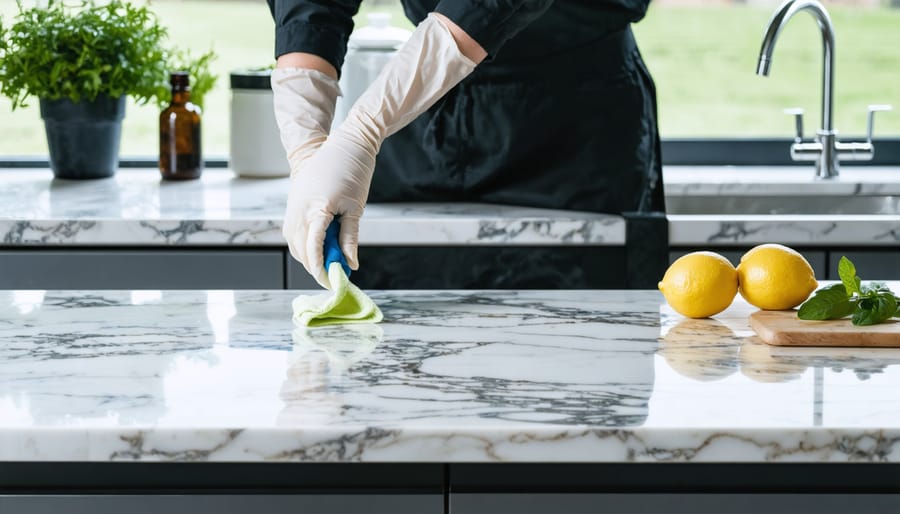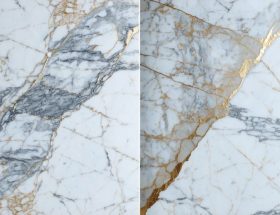Seal your marble countertops every 6-12 months with a penetrating sealer to create a protective barrier against bacteria, stains, and moisture infiltration that could compromise both aesthetics and hygiene. This simple preventive measure significantly reduces the porous surface’s vulnerability to harboring harmful microorganisms while extending your investment’s lifespan.
Clean daily with pH-neutral, non-toxic solutions specifically formulated for natural stone—avoid acidic cleaners like vinegar, lemon juice, or harsh chemicals that etch the surface and create microscopic grooves where bacteria can thrive. A mixture of warm water and mild dish soap effectively removes food particles and germs without damaging the calcium carbonate composition of marble.
Wipe spills immediately, particularly acidic substances like wine, coffee, citrus, and tomato-based products that penetrate the surface within minutes, causing permanent etching and potential bacterial growth in damaged areas. This practice protects both your countertop’s structural integrity and your family’s health.
Address marble design considerations during installation by incorporating proper ventilation, adequate lighting for cleanliness inspection, and strategic placement away from high-impact zones to minimize chipping hazards.
Understanding the intersection between marble maintenance and health safety empowers you to make informed decisions about protecting your investment while ensuring a hygienic food preparation environment. Proper care transforms marble from a potentially vulnerable surface into a durable, safe, and stunning centerpiece that serves your household for decades without compromising wellness or aesthetic appeal.
Understanding Marble’s Porous Nature and Bacterial Growth Risks
Why Sealing Is Your First Line of Defense
Marble’s natural porosity makes it susceptible to absorbing liquids, food particles, and bacteria deep into its surface. Without proper protection, these microscopic pores become breeding grounds for harmful microorganisms, compromising both the stone’s appearance and your family’s health. This is where professional-grade sealing becomes essential as your first line of defense.
A quality penetrating sealer fills these pores, creating an invisible barrier that prevents contaminants from infiltrating the stone while still allowing it to breathe. For most marble countertops in kitchens and bathrooms, resealing every 6-12 months maintains optimal protection. High-traffic areas or lighter-colored marbles may require more frequent attention, while darker stones with tighter grain structures might extend this timeline.
Testing your marble’s seal is simple and takes just minutes. Place a few drops of water on the surface and observe. If the water beads up and remains on top for at least 30 minutes, your seal is intact. However, if the marble darkens or absorbs the water within 10-15 minutes, it’s time to reseal. This simple test should become part of your proper marble maintenance routine every few months.
Beyond bacterial protection, sealing also guards against staining from acidic substances like lemon juice, wine, and coffee—common culprits that can permanently etch and discolor unsealed marble. Investing in professional sealing or using contractor-recommended products ensures your countertops remain both beautiful and hygienic for years to come.
The Water Test: Checking Your Marble’s Vulnerability
A simple water test reveals whether your marble countertop’s sealer is providing adequate protection. Start by placing a few tablespoons of water on an inconspicuous area of your countertop. For comparison, also place water on a high-traffic zone where the seal may have worn down.
Observe what happens over the next 10 to 15 minutes. If water beads up and remains on the surface, your sealer is functioning properly. However, if the water darkens the marble or begins absorbing into the stone, your countertop needs resealing.
This test works because marble is naturally porous—its calcium carbonate composition creates microscopic channels that readily absorb liquids. Without proper sealing, these pores become entry points for bacteria, stains, and moisture that can compromise both the stone’s appearance and hygiene.
Perform this water test every three to six months in your kitchen, and annually in lower-traffic areas like bathrooms. Regular testing helps you stay ahead of potential problems, preventing bacterial growth in porous areas and maintaining a sanitary food preparation surface. Document your results with photos and dates to track sealer performance over time.
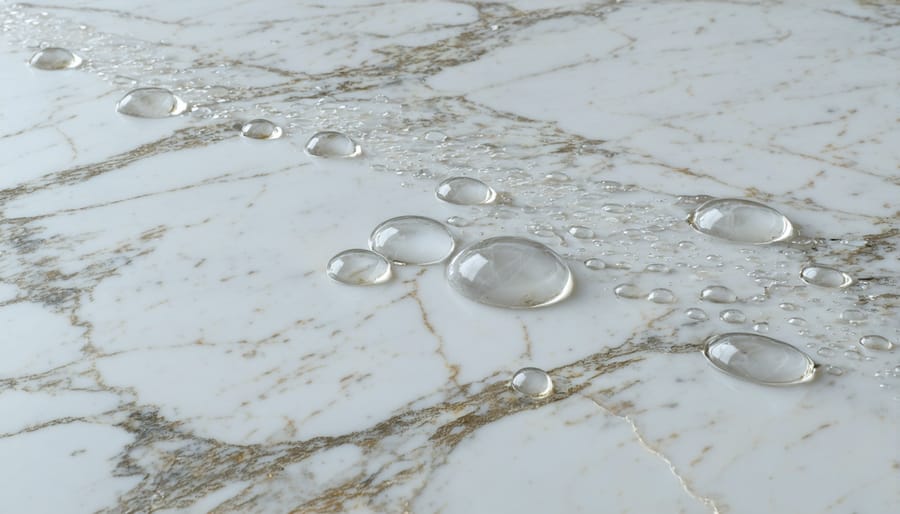
Safe Cleaning Practices That Won’t Harm Your Health or Your Marble
What to Avoid: Cleaning Products That Create Health Hazards
Protecting your marble countertops requires knowing which cleaning products to avoid. Many common household cleaners contain ingredients that can permanently etch marble’s surface while creating dangerous health hazards in your kitchen.
**Acidic Cleaners: The Double Threat**
Vinegar, lemon juice, and cleaners containing citric acid will immediately damage marble’s calcium carbonate structure, creating dull spots and surface erosion. Beyond damaging your countertop, these acids can release calcium compounds into the air and leave residues that contaminate food preparation areas.
**Ammonia-Based Products**
Window cleaners and multi-surface sprays often contain ammonia, which dulls marble’s finish over time. When used in enclosed spaces, ammonia vapors irritate eyes, throat, and lungs, posing particular risks to those with respiratory conditions.
**Bleach: A Critical Hazard**
Never use bleach on marble countertops. While it won’t damage sealed marble as severely as acids, bleach creates serious health risks. The toxic fumes can cause respiratory irritation, and any residue left on food-contact surfaces presents ingestion hazards. Most critically, if bleach accidentally mixes with other cleaning products, it can create deadly chlorine gas or toxic chloramines.
**Common Problem Products**
Avoid all-purpose cleaners, bathroom cleaners, and anything labeled “antibacterial” unless specifically formulated for natural stone. These typically contain acids, harsh alkalines, or abrasives that compromise marble’s integrity. Even “natural” cleaners marketed as eco-friendly often contain citrus acids that etch marble surfaces while creating a false sense of safety.
Safe, Effective Cleaning Solutions for Daily Use
Maintaining marble countertops safely requires choosing cleaning solutions that effectively remove bacteria and grime without damaging the stone’s delicate surface. The key is selecting pH-neutral cleaners specifically formulated for natural stone, as acidic or alkaline products can etch or dull the marble’s finish over time.
For daily cleaning, mix a simple DIY solution of warm water with a few drops of mild dish soap. This combination safely removes surface dirt and food residues without introducing harsh chemicals into your home. Apply the solution with a soft microfiber cloth using gentle, circular motions, then rinse thoroughly with clean water and dry immediately to prevent water spots and mineral deposits.
Commercial safe cleaning products designed for marble should have a pH level between 7 and 10. Always check product labels to confirm they’re stone-safe and free from acids, ammonia, bleach, or vinegar—common household cleaners that can cause irreversible damage to marble surfaces.
For stubborn stains, create a paste using baking soda and water, apply it to the affected area, cover with plastic wrap, and let it sit for 24 hours before wiping clean. This method lifts stains without chemical abrasives.
Never use abrasive scrubbing pads or powders, as these scratch the marble’s surface, creating microscopic crevices where bacteria can harbor. Instead, rely on soft cloths and proper cleaning frequency—wiping down surfaces after each use and performing deeper cleaning weekly—to maintain both hygiene and stone integrity.
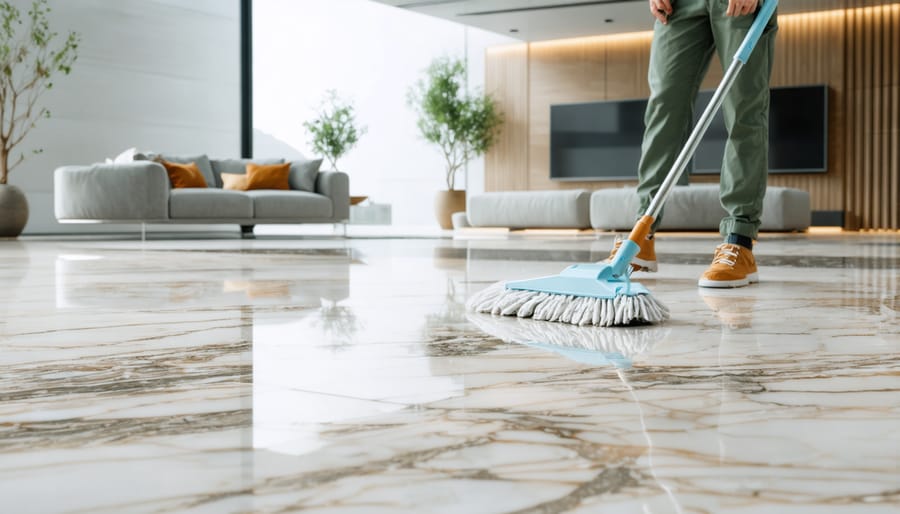
Preventing Cross-Contamination in Food Preparation Areas
Marble’s porous nature requires special attention when preparing food, particularly when handling raw meat, poultry, and seafood. These proteins can harbor harmful bacteria like Salmonella and E. coli that may penetrate the stone’s surface if not addressed promptly. Always use cutting boards rather than cutting directly on marble, and immediately clean any areas that contact raw proteins with warm water and mild dish soap.
After washing, sanitize the surface using a solution specifically designed for natural stone or a mixture of isopropyl alcohol and water (70% alcohol concentration). Avoid harsh disinfectants containing bleach, ammonia, or acidic ingredients like vinegar, as these will etch and damage the marble finish. Apply the sanitizing solution, let it sit for several minutes, then wipe clean with a soft cloth and dry thoroughly.
Designate specific preparation zones for different food types when possible. Keep raw meat preparation separate from areas used for ready-to-eat foods like fruits and vegetables. This practice, combined with proper cleaning between tasks, significantly reduces cross-contamination risks.
For maximum food safety, ensure your marble countertops are properly sealed. A quality sealer creates a protective barrier that prevents bacteria and liquids from penetrating the stone’s pores. Test your seal regularly by placing a few drops of water on the surface—if the water beads up, your seal is intact. If it darkens the stone, resealing is needed.
Establish a routine cleaning protocol: wipe surfaces before and after food preparation, address spills immediately, and perform deep sanitization after handling raw proteins. Keep separate sponges or cloths for countertop cleaning to prevent introducing bacteria from other kitchen areas. By following these protocols consistently, marble countertops can serve as safe, beautiful food preparation surfaces for years to come.
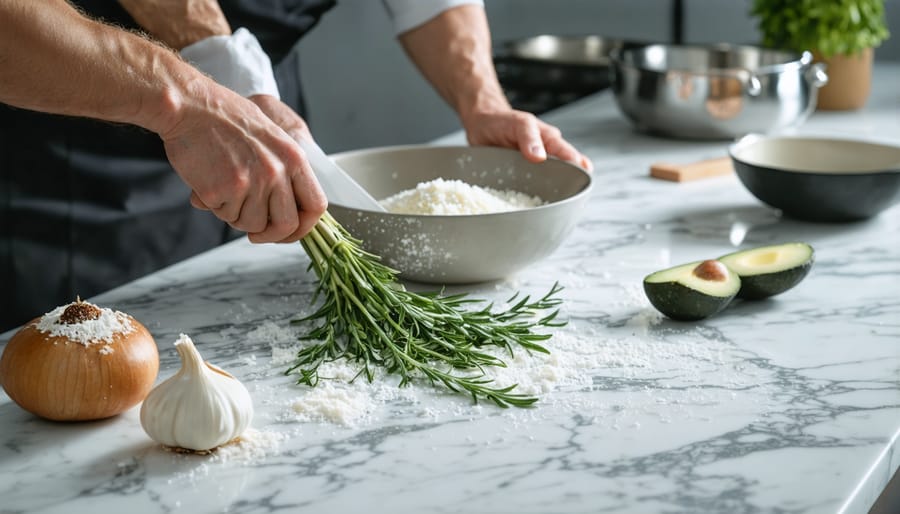
Stain Prevention as a Health Issue: Why It Matters Beyond Aesthetics
While stains on marble countertops are commonly viewed as aesthetic concerns, they represent a more significant health consideration that warrants attention. When liquids penetrate marble’s porous surface, they don’t simply discolor the stone—they create conditions where bacteria, mold, and other microorganisms can thrive in the substrate beneath the surface.
Common staining agents pose varying levels of health risk. Acidic substances like wine, coffee, and citrus juices not only etch marble but can seep into microscopic pores, creating organic matter that bacteria feed on. More concerning are protein-based liquids such as raw meat juices or dairy products, which can harbor harmful pathogens like E. coli and Salmonella within the stone’s structure. Oil-based stains, while less immediately hazardous, can turn rancid over time and develop unpleasant odors.
The key to preventing these health issues lies in immediate response. When spills occur, blot—never wipe—the liquid with a clean, dry cloth to prevent spreading. Follow with a pH-neutral stone cleaner and thoroughly dry the area. For food preparation surfaces, this protocol becomes critical to maintaining a hygienic environment.
Understanding that stains represent absorbed substances rather than surface-level marks emphasizes why preventive measures matter. Regular sealing creates a protective barrier that gives you precious time to address spills before they penetrate, transforming marble maintenance from a cosmetic concern into an essential health practice.
Physical Safety Considerations: Chips, Cracks, and Sharp Edges
Damaged marble countertops present legitimate safety hazards that require immediate attention. Chips, cracks, and sharp edges can cause cuts, scrapes, and other injuries during everyday kitchen activities. These physical defects typically occur from impact damage, improper installation, or natural wear over time, creating potentially dangerous surfaces in high-traffic work areas.
Regular inspection is your first line of defense against these hazards. Run your hands carefully along edges and surfaces monthly to detect any rough spots, chips, or developing cracks. Pay particular attention to areas around sinks, cooktops, and countertop edges where damage commonly occurs. Even small chips can have razor-sharp edges capable of causing injury, especially to children who may be at countertop height.
Minor chips and rough edges can often be smoothed with fine-grit sandpaper or a specialized stone honing compound, though this approach works best for small imperfections. For more significant damage, professional repair becomes essential. Stone fabricators can fill cracks with color-matched epoxy, re-polish damaged areas, and grind down sharp edges to restore both safety and aesthetics.
Never attempt to repair structural cracks or large chips yourself, as improper repairs can worsen the problem and create additional safety risks. Professional stone restoration specialists have the expertise and tools to assess whether damage requires simple repair or complete section replacement. When cracks extend through the full thickness of the marble or appear near support areas, immediate professional evaluation is critical to prevent catastrophic failure and potential injury.
Creating a Maintenance Schedule That Protects Your Family
Daily and Weekly Maintenance Protocols
Establishing consistent cleaning routines is essential for preventing bacterial growth and maintaining marble’s natural beauty. Daily maintenance requires minimal effort but provides maximum protection against health hazards.
Each day, wipe down marble countertops with a soft microfiber cloth and warm water immediately after use, particularly after food preparation. For light cleaning, use a pH-neutral stone cleaner specifically formulated for marble—avoid acidic substances like vinegar or lemon juice, which can etch the surface and create microscopic crevices where bacteria thrive. Always dry the surface completely with a clean cloth to prevent water spots and mineral deposits.
Weekly deep cleaning involves a more thorough approach. Apply a marble-safe cleaner across the entire surface, allowing it to sit for 2-3 minutes before wiping clean. Pay special attention to edges, seams, and areas around sinks where moisture accumulates. Inspect the sealant integrity by performing the water droplet test—place a few drops of water on the surface; if absorbed within 10 minutes, resealing is necessary.
Remove any standing water from soap dispensers or decorative items weekly, as prolonged moisture exposure can compromise the sealant and promote bacterial colonization. These simple protocols significantly reduce contamination risks while preserving your marble’s integrity.
When to Call a Professional: Red Flags You Shouldn’t Ignore
While proper maintenance can prevent most issues, certain warning signs indicate it’s time to consult a stone restoration professional. Deep cracks or chips that penetrate the surface can harbor bacteria and compromise structural integrity, creating both health and safety concerns. Stubborn stains that persist despite proper cleaning techniques may indicate chemical etching that requires professional polishing and resealing.
If you notice persistent moisture accumulation, cloudiness, or discoloration that spreads despite regular care, these could signal underlying damage or improper installation that allows water infiltration. This moisture can promote mold growth, posing respiratory health risks.
Worn or uneven surfaces with pronounced etching patterns not only appear unsightly but can trap food particles and bacteria in microscopic pores, making thorough sanitization difficult. Similarly, if your countertop develops a dull, rough texture despite regular maintenance, the protective seal has likely failed completely.
Contact a certified stone professional immediately if you detect mold growth, persistent odors, or significant structural damage. These experts can assess whether restoration is possible or if replacement sections are necessary to maintain safe, healthy food preparation surfaces. Professional intervention protects both your investment and your family’s wellbeing.
Proper care and maintenance of marble countertops extends far beyond aesthetic considerations—it’s a fundamental aspect of protecting your family’s health and ensuring a safe kitchen environment. Throughout this guide, we’ve explored how bacteria can harbor in porous surfaces, how acidic substances can compromise marble’s integrity, and how the wrong cleaning products can introduce harmful chemicals into your home. The good news is that with consistent, informed practices, marble countertops can deliver both timeless beauty and a hygienic surface for food preparation.
The key to success lies in establishing a routine that addresses marble’s unique properties. Regular sealing creates a protective barrier against pathogens and stains, while using pH-neutral cleaners preserves the stone without introducing toxic residues. Daily maintenance takes just minutes but pays dividends in longevity and safety. When spills occur, immediate action prevents permanent damage and bacterial growth. By understanding marble’s vulnerabilities and responding appropriately, you’re not just maintaining a surface—you’re investing in your home’s value and your family’s wellbeing.
Now is the time to evaluate your current approach. Are you sealing your countertops according to manufacturer recommendations? Do your cleaning products align with marble-safe standards? Are you addressing spills promptly? Take a few moments today to assess your maintenance routine against the guidelines in this article. Small adjustments can make a significant difference in both the beauty and safety of your marble countertops for years to come.

